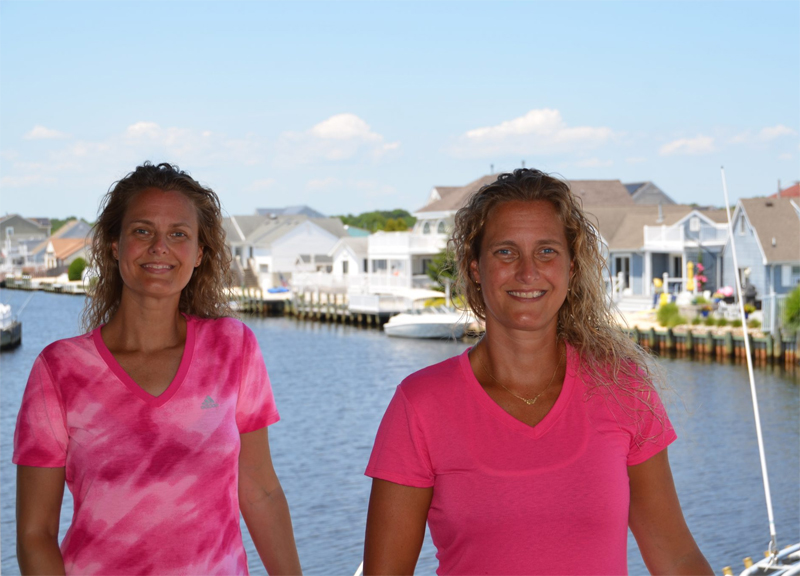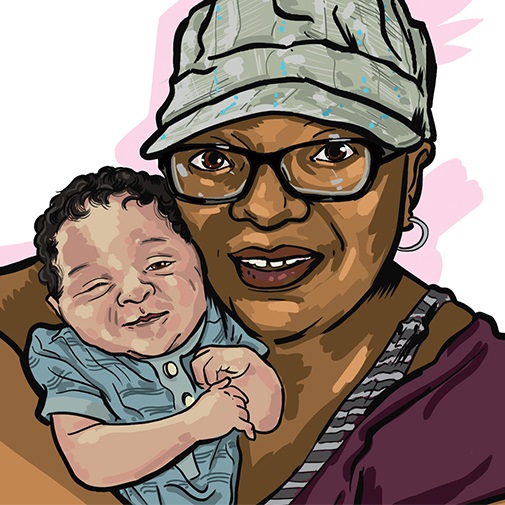Mirror Image

August 05, 2020
Courtney, who lives in Manahawkin, is older than Meagan, who lives in Waretown, by two minutes. She was often the first to try new things, such as field hockey, which Meagan would later join. That trend changed last year.
“I’m usually the trailblazer, but she beat me for the first time in our lives,” says Courtney. “She got cancer first.”
Unpleasant Surprises
Meagan had a routine mammogram in October 2019. Her results came back clear, but because she has dense breast tissue, she also received an automated breast volume scanner (ABVS) ultrasound.
“In younger patients, breast cancers are more difficult to find if the patient has dense breasts,” says Southern Ocean Medical Center radiation oncologist Joseph Lattanzi, M.D., who estimates that about 10 percent of patients with dense breast tissue have underlying lesions, and about half of women under age 40 have dense breast tissue. Computer-assisted screening tools used by Hackensack Meridian Health providers give a precise breast density reading, which determines a patient’s risk of cancer being missed on their mammogram, adds Thomas Yu, M.D., radiologist at Health Village Imaging.
Meagan’s ABVS ultrasound revealed an abnormality, so she made an appointment at Ocean University Medical Center with breast surgeon Yolanda Tammaro, M.D., who recommended a biopsy to confirm if the abnormality was cancerous. Because of her age—42—the fact that she had no family history of breast cancer, had three pregnancies and breastfed all her children, it was very unlikely that anything was amiss.
But on Wednesday, January 15, 2020, Meagan got the unbelievable news that she had breast cancer.
“I didn’t even tell my sister until the Sunday after the biopsy,” Meagan says. “I was so shocked, I just couldn’t say it. We tell each other everything, but I didn’t want her to worry.”
After learning of Meagan’s diagnosis, Courtney’s mind went back to the mammogram she had put off over the holidays. She made the next available appointment in March, but prior to that, she did a self-examination and found a lump. In disbelief, she told herself it was a sympathy lump. What she didn’t know was that Meagan’s lump was in the exact same spot.
Dr. Tammaro removed Meagan’s lump in February, sparing her breast. When Courtney visited Meagan the day after the surgery, she kept quiet about the lump she had found. She didn’t want to upset Meagan, especially without knowing what it was. But when Meagan showed her the location of her incision, Courtney couldn’t hide her shock.
“She went pale as a ghost,” Meagan recalls.
Twin Diagnoses
The following week Courtney told Meagan about her strangely similar mass. Meagan implored Courtney to ask for the ABVS ultrasound at her upcoming mammogram. “I told her, ‘Tell them what happened to me,’” Meagan says, “because if I hadn’t gotten that done, I would have cancer now and not know it.”
When Courtney’s ABVS results came back, they showed the suspicious mass, and like her sister, a biopsy confirmed that she, too, had breast cancer.
By the time Courtney received her diagnosis, Meagan had already finished the first part of her three-step treatment plan—surgery—and was onto the next—radiation. She gave Courtney the names of each of her doctors, and Courtney requested the exact same lineup.
“Having all of her doctors was such a huge help,” Courtney says. “She did so beautifully that I had no doubt in my mind I would do the same. She told me, ‘Everyone is going to be super nice to you,’ and everybody was. I never once felt like they were treating me like I was my sister. I was my own individual.”
Courtney met Dr. Tammaro first. Her biopsy was scheduled in the thick of New Jersey’s COVID-19 outbreak, which meant she had to go to visits alone or schedule virtual visits when appropriate. Southern Ocean oncologist Tricia Morino, D.O., prescribed tamoxifen, an estrogen-modulating drug, to treat the breast cancer while Courtney waited for her lumpectomy.
Prior to the sisters’ surgeries, Dr. Tammaro ordered genetic testing to determine whether a lumpectomy (which removes just the tumor) or a mastectomy (which removes the whole breast) would be the best treatment. Then, Dr. Morino ordered Oncotype testing, which determines whether chemotherapy will be an effective treatment.
Both sisters were found to be negative for genetic mutations, and although their tumors fell into the intermediate risk category based on the Oncotype, their age and cancer-free family history helped their doctors decide that chemo was unnecessary.
On the Road to Remission
Meagan completed radiation on May 5, and Courtney began hers on June 24. As Meagan recovered, her progress was a preview of the road ahead for Courtney. “I kept telling her, ‘You’re going to feel like yourself again soon,’” Meagan says.
Looking back on the whirlwind they have faced, both women say the hardest part was watching the other go through it. “I didn’t even have a chance to process that I had cancer before we scheduled my surgery,” Meagan says. “I was 10,000 times more afraid for my sister. My experience was over and done with, but I had to watch her go through it.”
Courtney echoes, “I was more scared and nervous for Meagan when she was going through her cancer diagnosis, waiting for all of her test results and surgery. It felt like it took a lifetime, and time almost stood still for me, but when living through it myself, I felt like it all went so fast. I feel like I blinked my eyes and my tests, surgery and radiation were over, and I was on my way to full recovery.”
The sisters had testing to determine if they carry a genetic mutation linked to their cancers, and both tested negative. Now they are onto step three, hormonal therapy, and they will keep up a rigorous surveillance program with each of their doctors to catch any sign of recurrence.
“They are my patients for life now, and I’m happy to say that because they’re beautiful women, inside and out,” Dr. Tammaro says. “They share the same spirit.”
Next Steps & Resources:
- Meet our sources: Joseph Lattanzi, M.D., Thomas Yu, M.D., and Yolanda Tammaro, M.D.
- To make an appointment withJoseph Lattanzi, M.D., Thomas Yu, M.D., Yolanda Tammaro, M.D.or another provider, call 800-822-8905 or visit our website
The material provided through HealthU is intended to be used as general information only and should not replace the advice of your physician. Always consult your physician for individual care.
Find a doctor near me
Dealing with Cancer, Anxiety & Fear During Coronavirus Pandemic
Living with cancer and its treatment is stressful. The COVID-19 pandemic has added another layer of anxiety for people already dealing with a diagnosis of cancer. Learn more about the things you can do to take control of your anxiety without letting it take control of you.
Partners in Cancer Care

Learn about advanced cancer care at Hackensack University Medical Center. Helena Theurer's generous donation transformed cancer treatment. Schedule an appointment today.
Find a doctor near me

Catching Lung Cancer Early
Early lung cancer detection saves lives. Learn how Diana's early diagnosis at Jersey Shore University Medical Center led to successful treatment. Get the information you need.

Life After Cancer
Life After Cancer: Arthur's pancreatic cancer journey. Learn how Jersey Shore University Medical Center's surgical expertise helped him recover. Learn more.
Woman’s Best Friend
Vernon, NJ sisters' breast cancer journeys. Learn about their experiences and treatment at John Theurer Cancer Center. Find support and hope.

Fighting Breast Cancer to Win
Breast cancer survivor Chereese McMillan shares her Mountainside Medical Center journey. Find hope and support. Learn more.
